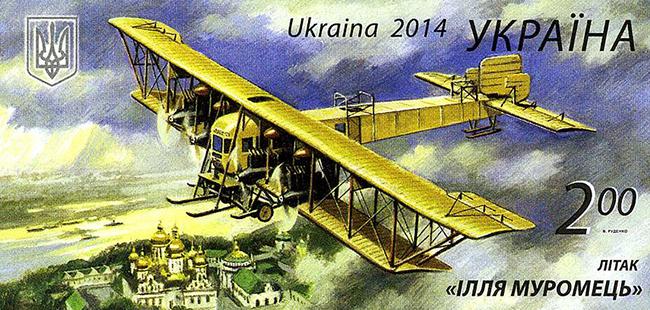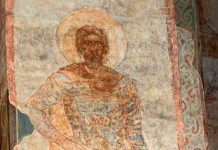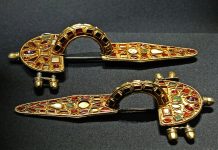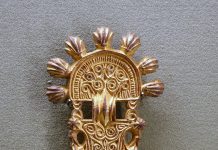“There was one more important test flight as well as demonstration left to be accomplished, namely a long journey across the country. Until then all flights had been in the neighborhood of Petrograd, never more than forty miles from the airport. As a test of the fuel consumption, we made a longer flight on June 18th. The plane was in good, order and it could have loaded even more heavily. After this test, I decided to make a flight to Kiev, my native city, in order to test and demonstrate the ship in a long flight… It was still dark during the first hour after the take-off. There were no lights on the instrument board and from time to time we used a flashlight to look over the instruments. At such times the cabin was lighted up but we could see nothing outside. Gradually, after 2 a.m., it grew brighter. The flight was extremely smooth. The plane slowly gained altitude, chiefly because it became lighter as fuel was consumed. Around 2.30 a.m. we reached about 2,000 feet. The engines were now working slightly below full power. The weather was excellent and the air smooth. Each one of the pilots spent half an hour at the controls, otherwise there was not much to do. Twice during this flight I climbed on the wing towards the outboard motor. There was no actual necessity for doing this because the engines worked well, but I wanted to be sure the engine could be repaired in the air. Behind the motor there was a space reasonably protected from the air stream. It was beautiful and interesting to watch from this point the huge body of the ship and the wide, yellow wings. It was a strange feeling to see these wings apparently motionless in the smooth, clear, and cool air of the early morning.
Another two hours passed. Flying steadily at an altitude of 5,000 feet, we pumped the spare fuel into the main tank and cleared the cabin of petrol containers. Around 7 a.m., while Captain Prussis remained at the controls, the rest of the crew got together in the large cabin. The table was covered with a cloth and a regular breakfast consisting of fruit, various sandwiches and hot coffee was served. We believed that this was the first time the meals were properly served on board a plane while in the air. We all enjoyed the food sitting in large, comfortable wicker arm-chairs around the table with glasses of coffee…
While over Vitebsk, we sent two telegrams, one to my home, and the other to the factory. In order to do this we would place a written message, with the necessary money and a small tip, in an eight-inch piece of aluminium tube stoppered at each end with a cork. We also endowed a note asking that the message be sent as soon as possible. Around the tube there was wound a long tape of bright cloth. When thrown out the cloth would unwind and make the falling tube visible. We dropped several messages in this manner during the trip, and each one was found and sent.
Soon after nine, we saw ahead of us the town of Orsha, and without any trouble located the field marked for our landing. I throttled the engines, and as we descended to a lower altitude the air became more bumpy and finally very rough below 2,000 feet. I landed, taxied towards the barrels of petrol, which I could see in one corner of the field, and ordered the ship refuelled. When we stepped out we were surrounded by a large and enthusiastic crowd. We received fresh fruit and various presents and were asked a multitude of wild questions… Lieutenant Lavrov and myself succeeded in getting away to inspect the field and make plans for the take-off…
When we returned to the ship around noon, we were disappointed by the slow progress in refuelling. The energetic efforts of many volunteers could not overcome the low capacity of the few petrol pumps which had been rented in the vicinity and almost one-half of the 400 gallons of fuel was still in the barrels. As the time went by we became somewhat disturbed, because we had no equipment and no experience in night flying at that time. The trip to Kiev would take another six hours and the nights in the south are dark, unlike the “white ” nights of northerly Petrograd. It was about 2 p.m. before the refuelling was finally completed.
In order to gain all possible speed, I made no take-off at all, I permitted the heavy ship to run all the way, and off the end into the ravine. The plane dropped down slightly but gained a little more and remained in the air. The Dnieper was crossed at about the level of the field, and I continued to fly level just above the roofs of the houses. After crossing the city we began to gain altitude, and I turned south. A minute or two later we got into trouble. It was after s p.m., the day was hot and along our way there were fields, forests and swamps, which caused different currents, and as a result the air was extremely bumpy. We reached some 250 feet altitude when a rough air gust threw us down to less than 100 feet. I ordered the three cans of spare water and one can of oil to be thrown overboard. Whether the result was mechanical for the plane or moral for the crew I do not know, but somehow I succeeded in staying in the air. Flying was extremely difficult. The overloaded ship with very little excess power could not gain altitude. When, after a few minutes of careful piloting with all four motors at full power, we would reach 400 to 500 feet, a rough air-pocket would again throw the ship down to some 200 feet or less. It was stifling hot in the cabin. I was tired after only fifteen minutes of this and I could not get any higher than a few hundred feet. I asked my mechanic and Captain Prussis to stay in the main cabin and to be ready for my order to throw overboard cans containing petrol and, if necessary, spare parts, because all the water and extra oil were already gone.
A few minutes later my mechanic rushed into the pilot’s cabin. Glancing at his face I realized that something was seriously wrong. He was pointing to the rear of the right inboard engine. Looking in that direction I saw the cause of his worry. The petrol tube was broken through a few inches from the carburetor, and the fuel was streaming out. The engine was still running at full power during that second, but before we could do anything it started backfiring a couple of times, and before it went dead the exhaust flame, or possibly the backfire, ignited the petrol leaking out of the pipe. A huge flame about twelve feet long sprang out, touching the surface of the wing and encircling the wooden strut. Lavrov and Panasiuk quickly climbed out on the wing and began to fight the flames with their overcoats. Lavrov stepped on the engine frame and, bending over the still strong flame, reached the shut¬off valve and closed the fuel line. After this, working furiously with their overcoats, the two men finally succeeded in checking the fire. We were less than 400 feet high, flying over woods, and the overloaded ship, with one dead motor, was now losing altitude. I made a complete turn and pointed the ship in the direction of a small field which I remembered seeing a few minutes before the fire started. Flying on three motors and steadily descending, I was able to bring the plane towards the field and make a good landing… once we stepped safely on the ground to inspect t the blackened struts and burned wing. all exactly below the huge petrol tank, we became somewhat “nervous”. Smiling and congratulating each other we realized that this had been a narrow escape…
In less than one hour the plane was again ready, but it was too late to start. There was not enough daylight left to reach Kiev and we decided to stay overnight. By that time a large, friendly and exited crowd had already gathered willing to offer assistance. With the help of the men we pushed the ship to the end of the field, turned it round and placed it m the proper position…
The night was cloudy and very dark as we went to sleep on board the plane. I used my own berth in the sleeping cabin, the first berth ever built into an aeroplane. About midnight drops of rain began drumming over the fabric of the fuselage. We got up before daybreak, and about four o’clock I ordered the motors started. At that time it was not raining, but heavy low clouds covered the whole sky and the morning was gloomy and dark.
Shortly after four, all motors were warmed up and soon everyone was at his post. The heavy ship started with some difficulty its run over the soft, wet field, but the steeper part of the slope helped and before the end of the meadow was reached we took off. There was no wind and the air was calm. The ship slowly but steadily gained altitude. We were slightly over 1,500 feet high when the city of Scklov was passed. We saw very little of it, however, because of the weather. Flying almost directly southward and gradually gaining altitude, we soon found ourselves in the clouds. It grew darker. During the first hour of flight it was smooth and even flying blind in the clouds was not difficult.
Then the weather began to change for the worse. The rain started again and the air became rougher and rougher. With no experience in blind flying, I had a hard time controlling the heavy ship in rough air. I might say that with the instruments we then had, I would not now fly blind. I would not even go up with them in bad weather. But then they were all we had; they had been extemporized to meet a need, and better instruments came in time with better aeroplanes. At that time we were pioneers, we used what we could and were grateful for any little aid that we could get…
I tried my best to fly the heavy ship, and with difficulty we reached an alttude of 2,500 feet. By this time the rain had become a real downpour. I worried about the motors, which were mounted entirely in the open, with the magnetos and wires exposed to the rain. However, they worked very well.
About six-thirty we were still flying blind in a very strong rain and rough air. Using full power, we could get only about 3,000 feet altitude, and every time a few hundred feet more were gained a powerful air gust would cast the plane down again. Once, after a minute or two of relative quietness, we felt a violent blast which threw the left wing down. Tired by the rough, blind flying, we did not realize at once what was going on, but we knew that something had happened, and that the plane was losing its normal flying position. We felt that in addition to the left wing, the nose had also turned downward. The hand of the compass had apparently become detached and made a couple of complete turns, while the altimeter showed a loss of 1.000 feet within a very short time. To confess the truth, I had lost all sense of direction of flight. The controls appeared loose and the ship did not obey the ailerons. Now, I know what had happened. The ship had gone into a spin, as we call it, because of lack of proper flying instruments and the sudden gust of air, and was spiralling, nose down, towards the earth. Instinctively, I must have done the only thing which will bring the pilot from such a spin — neutralized the controls and let the plane pick up speed and come out of its own accord. I succeeded in straightening out the plane again after a loss of more than 1,200 feet of altitude. I found out later that I was not the only one at that time who thought our ship might keep right on falling until it crashed into the ground. That was my first experience with a spin, which everyone who has been to an air show has seen as a simple manoeuvre. When done deliberately, and with sufficient altitude, in clear weather, it may be a pleasant experience to the pilot who enjoys acrobatics, but to us it was not only a novel but somewhat perturbing incident, particularly as we could see nothing, and did not know what was happening. The ship came out of the spin entirely off the course. It was still very bumpy and raining hard and we could not see 100 feet ahead. Obviously in that rough air we would not be able to climb over the heavy rain clouds, so after a brief discussion with Lavrov, I decided to come down and continue the flight, if possible, below the clouds where we would at least see something…
Ikt engines were throttled down. We watched the altitude, and looked ahead for a break in the clouds. At less than 800 feet when we were becoming somewhat uneasy, we finally saw the ground in a haze through a screen of heavy rain. The green wood and pastures, barely visible through the downpour, offered no distinguishing landmarks by which we could locate our position on the map…
“…there’s the Dnieper,” I cried as I saw a gleam of water which I recognized instantly as the great river. We changed our course again to the south and followed the river for a few minutes until we located ourselves on the map about half-way between Orsha and Kiev. We continued to fly for about one hour, staying as high as possible, about 800 feet without losing sight of the ground…
Around half-past seven, we decided to try to escape the rain. With engines wide open, the ship started to climb. A few moments later the ground disappeared and we entered the clouds… With a substantial amount of petrol already consumed, the plane continued to climb. We exceeded 3,000 feet, and it was still raining. Gradually, the plane reached 4,000 feet. There was less rain, but the clouds closed in still thick. The ship mounted steadily. A few minutes later the rain cleared, and the gloomy darkness started to melt away. Around 5,000 feet the light began to increase quickly, and a few moments later the huge ship emerged from a layer of dazzling white clouds into the bright sun and beautiful clear blue sky above… We decided to stay above the clouds all the time and to come down only when we could expect to be above Kiev.
I drank a glass of coffee, put on my warm overcoat and went to the upper bridge of the ship. A fresh, cool wind compelled me either to hold on to the rails or to stand obliquely. Only a few times in my life have I seen such a majestic and beautiful spectacle as I did then. With the power of the engines reduced to slow cruising, our ship was gliding along a few hundred feet above a sparkling white surface. The air was calm and the plane seemed motionless with its huge \ ellow wings stretched out some twenty feet ahead of where I was standing on the upper platform. All around me there was a fairyland, formed by clouds. The surface was not at all even. From time to time the plane would pass dose to a strange-looking mountain. Next there would be a gigantic mushroom several hundred feet high. When we passed dose to it, the cloud motion below its huge head would become apparent and a few bumps would be noticeable. For a long time I stayed alone on the platform admiring the wonderful fairy panorama—the strange beauty of which I will never forget. Time and time again I have had chances to fly above the clouds in an airplane in most parts of the world, but the impressions of this flight were never repeated.
This was not only because of the exceptional splendor of the scenery of that morning, it was also because of the sightseeing point of the upper platform. In fast, modern planes, looking through the window or even sitting behind the windshield in an open cockpit, one cannot see so completely as when standing entirely in the open, far behind the wings, on a narrow fuselage platform. Eventually, my frozen hands made it necessary to return to the cabin. I went down and took one of the comfortable wicker chairs near a window, and looked at a beautiful picture, but in the open I had seen and felt some majestic and strange reality. The two hours of flight above the clouds were easy and uneventful…
Finally, after about two and a half hours of flight without once seeing the ground, Lavrov informed us that Kiev must be about five miles straight ahead. I stepped into the pilot’s cabin, took the controls, throttled down the engines, and started to descend. The brilliant white surface was now quickly approaching. A minute later the plane descended into an un¬ broken sea of clouds. The bright sunlight and the blue sky disappeared, dark quickly surrounded us.
We entered the clouds at slightly below 5,000 feet. As the place came down gradually, it grew more and more dark. It was not raining and reasonably smooth, but we got the impression of flying in a dense fog. Gradually descending we were still in that fog while the altimeter showed less than 2.000 feet. During the next couple of minutes were began to feel uneasy. Finally, at about 900 feet, the plane suddenly emerged from the clouds. Directly ahead and below we saw the golden domes of the Lavra Cathedral of Kiev, while to the left I recognized the well-known chain bridge across the Dnieper.
A quick turn, another few minutes of flight over the familiar suburbs of my home town and we were landing on the Kourenev Airport, the same one on which three years earlier I had made my first flight.
[Note. The Kourenev Airfield was situated not far from the Pochaina Metro Station in the area of present-day Kurenivka District of Kyiv]
PART 2: Igor Sikorsky with his ‘Ilya Muromets’ plane in Kyiv >










